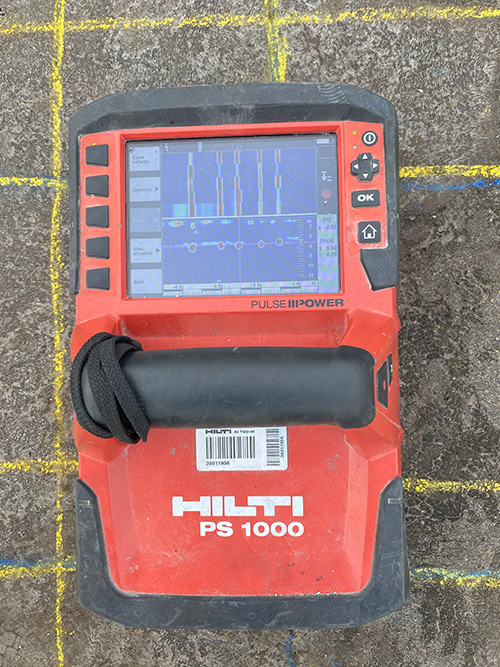Looking Into Precision: the Function of Concrete Scanning in Enhancing Building And Construction Security and Performance
In the realm of modern-day construction practices, the ins and outs of safety and security and performance have actually come to be paramount considerations. Concrete scanning, a technology that has acquired considerable traction in the industry, plays a vital duty in boosting these basic facets of building and construction tasks. By supplying a precise understanding right into the make-up and format of concrete frameworks, this ingenious technique not only enhances security steps on site but additionally adds to maximizing task planning. The ramifications of concrete scanning extend far past surface-level advantages, guaranteeing an ingrained influence on the general success of building endeavors.
Value of Concrete Scanning Modern Technology
Concrete scanning modern technology plays a critical function in making certain the safety and security and structural honesty of building jobs. By using numerous scanning approaches such as Ground Permeating Radar (GPR) and electromagnetic induction, construction groups can identify embedded things, rebar, conduits, and various other possible blockages within concrete frameworks before starting any boring or cutting activities. This modern technology helps stop unintentional damages to crucial facilities, reduces the risk of architectural failings, and enhances general task efficiency.
Additionally, concrete scanning enhances worker safety and security by providing precise information about the condition of concrete aspects, permitting teams to prepare and carry out building tasks with accuracy. The capacity to visualize subsurface functions in real-time makes it possible for task managers to make informed decisions, reduce prospective threats, and follow project timelines efficiently. Furthermore, by recognizing any kind of abnormalities or defects at an early stage, building and construction groups can implement corrective actions immediately, avoiding costly rework and delays in the construction process.
Fundamentally, the importance of concrete scanning technology hinges on its capacity to guard building and construction jobs, enhance operations, and support the highest standards of safety and security and top quality in the sector.
Enhancing Precaution on Site

Concrete scanning technology plays a crucial duty in boosting safety by enabling building groups to properly locate potential risks such as rebar, channels, and post-tension wires installed within concrete frameworks. By identifying these risks in development, employees can take essential preventative measures to avoid accidents during drilling, cutting, or coring activities. This positive technique not just safeguards the health of employees yet additionally helps in preventing costly damages to the structure.
Incorporating concrete scanning into security methods demonstrates a commitment to prioritizing safety on construction sites, ultimately leading to more successful and efficient task end results.
Optimizing Construction Task Preparation
Effective job planning is vital for the effective execution of building and construction tasks. Enhancing building and construction job planning entails a thorough technique to scheduling, source allowance, and danger anonymous administration. By leveraging advanced technologies like Structure Info Modeling (BIM) and concrete scanning, project supervisors can enhance the planning procedure and enhance total job performance. BIM enables the production of detailed 3D versions that offer understandings into the spatial partnerships between different task aspects, aiding to identify prospective clashes and problems at an early stage. In addition, concrete scanning allows the exact detection of subsurface utilities and frameworks, reducing the danger of pricey hold-ups and rework throughout the construction phase. By incorporating these modern technologies into the planning stage, building and construction teams can proactively deal with obstacles, improve sychronisation in between various professions, and guarantee that jobs are finished on time and within budget. Eventually, maximizing building and construction project planning is vital for taking full advantage of performance, decreasing waste, and delivering successful outcomes in the developed atmosphere. Concrete Scanning.
Lessening Job Delays and Risks
To reduce project hold-ups and threats, careful planning and positive risk administration strategies are necessary in the construction market. Hold-ups in building tasks can result in significant monetary losses, harmed credibilities, and also safety dangers.
Having backup strategies in location for common risks in building and construction, such as damaging climate problems or material shortages, can aid alleviate the effect of these elements on project timelines. By focusing on planning and risk management, building and construction groups can reduce project hold-ups and see page dangers, ultimately leading to more reliable and effective results.
Improving General Efficiency and Performance
Provided the relevance of thorough preparation and aggressive risk management in minimizing project hold-ups and threats in building and construction, an emphasis on boosting total performance and performance comes to be essential. Improving efficiency and productivity in construction tasks entails simplifying procedures, enhancing resource allocation, and minimizing downtime. Spending in devices and methods that prioritize efficiency and productivity not just advantages private construction tasks yet likewise contributes to the overall development and success of the building market.

Final Thought
In conclusion, concrete scanning modern technology plays a vital function in boosting building and construction safety and performance by enhancing safety procedures on site, optimizing job planning, lessening delays and threats, and eventually increasing general productivity. This innovation is crucial for making sure the successful completion of building and construction projects while focusing on the safety of workers and decreasing prospective threats. Its implementation can substantially benefit the building sector in achieving greater degrees of precision and efficiency.
Concrete scanning modern technology plays an essential function in making certain the safety and structural honesty of construction projects. Furthermore, by recognizing any issues or abnormalities early on, construction teams can carry out rehabilitative steps immediately, staying clear of costly rework and delays in the building procedure.
Reliable project planning is vital why not try these out for the effective execution of building tasks. Investing in tools and practices that prioritize performance and performance not only benefits individual construction projects but likewise adds to the total growth and success of the construction industry.
In final thought, concrete scanning innovation plays a vital duty in boosting building and construction safety and security and performance by improving safety steps on site, optimizing task preparation, decreasing threats and hold-ups, and eventually boosting general efficiency. - Concrete Scanning